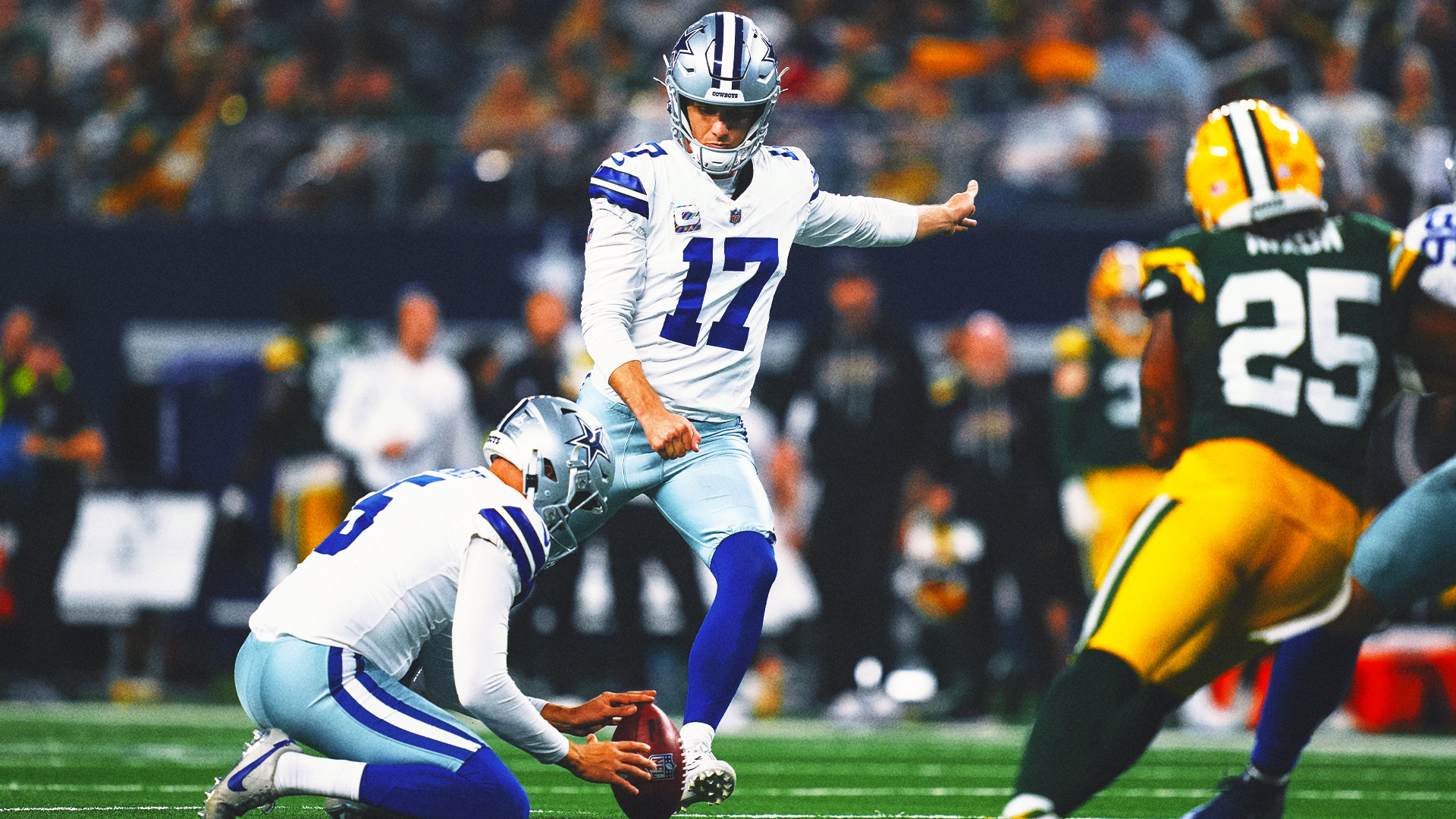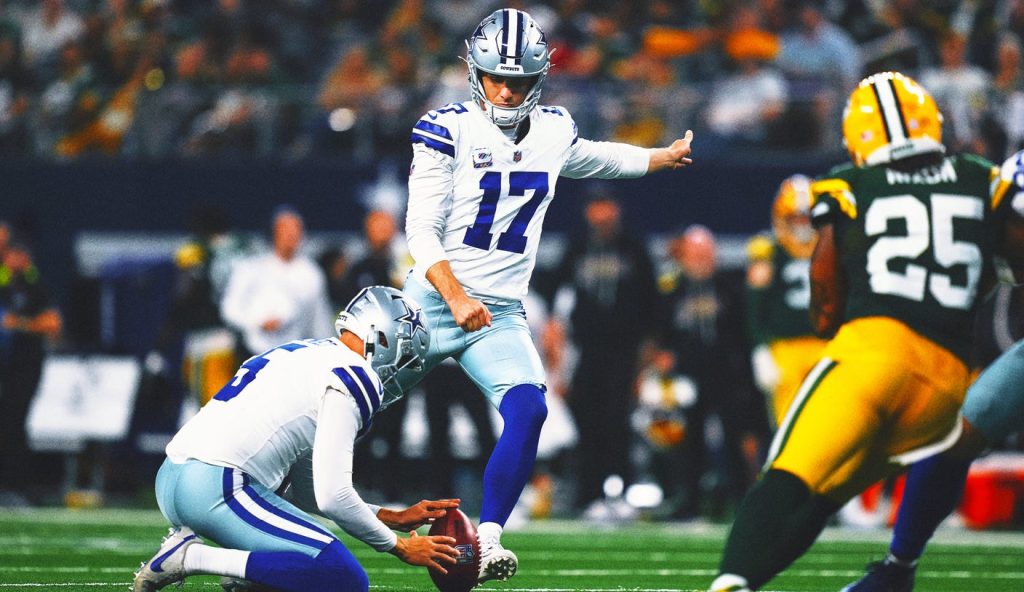
When Tampa Bay Buccaneers kicker Chase McLaughlin made field goals from 58 and 65 yards in a loss to the Philadelphia Eagles in September, Eagles defensive coordinator Vic Fangio made a striking comparison in the increase of long field goals made in the NFL this season to MLB’s steroid era.
“These kicking balls that they changed this year have drastically changed the kicking game,” Fangio said. “Field goals, in particular. It’s almost like they need an asterisk era, like the live ball era, like it was the live ball era, or the asterisk for those home runs that [Barry] Bonds or [Sammy] Sosa or [Mark] McGwire were hitting. The way they have changed the ball, the NFL has drastically changed the field goals.”
Fangio’s comments were in reference to the change in procedure for how kicking balls, or K-balls, are handled by teams in preparation for kickers and punters to use them in the game. Previously, equipment managers chose new balls out of the package on game day and were given from 45 to 90 minutes before game time to break them in, leading to an inconsistency in ball conditions each week.
But after a new rule was passed by the league over the offseason, the league distributed 60 Wilson kicking balls to each team for the entire season. Equipment managers now have the entire week to break the balls for games, using a wet towel or a Wilson ball brush before bringing three K-balls for inspection by NFL officials two hours and fifteen minutes prior to kickoff.
Former NFL kicker Nick Novack, who now trains pro, college and high school kickers in San Diego, credited Ravens senior special teams coach Randy Brown as the driving force behind the new procedure, lobbying the NFL for the rule change for how kicking balls should be handled and had sought a change in the process for years.
That led to the NFL approving the rule change by a 31-1 vote in March.
This year, NFL owners approved by a 31-1 vote the rule change back in March.
“All the kickers really should be thanking Randy Brown for this,” Novak told me. “He’s the pioneer. He fought for it, and it will be a lasting legacy that he leaves with the game.”
Even though the rules have been changed to give specialists more leeway in how they prepare K-balls for games, not all the statistics necessarily back up Fangio’s claims that the ball is juiced. The 84.7% field goal percentage league-wide through seven games is slightly lower than the league average of 85.6% for the entirety of last season.
However, the difference that Fangio points to is that NFL coaches are more willing to allow kickers to try longer field goals, and kickers have been making them. This year’s 70.6% field goal percentage from 50-plus yards would be the top percentage in league history from beyond 50 yards if it stands for a full season. Kickers have made 6 of 10 field goals from 60 or more yards this year entering Week 8.
For reference, kickers made 19 of 56 field goals (33.9%) from 60-plus yards between 2020-24, according to FOX Sports Research. Justin Tucker’s NFL-record 66-yard field goal in 2021 was the highlight of those made kicks, but Kickers took an average of 11 kicks a year from 60 or more yards during that time. They’ve already attempted 10 through seven weeks of the regular season.
All-Pro and former UFL product Brandon Aubrey has already taken (and made) two 60-plus-yard field goals for the Dallas Cowboys this season. In fact, his 61-yard field goal in the Cowboys’ win over the Washington Commanders in Week 7 was his fifth 60-yard field goal make in his career, giving him the NFL record.
Like fashioning a baseball glove the way you want it or playing with hoops with a basketball with good feel, playing with equipment that you are familiar with builds confidence, and that gives you an edge on game days, Novak said.
“I don’t think it adds distance like that,” Novak told me. “I think it’s just the balls are perfect. And perfect might be different from kicker to kicker and what they like. For me, you want to make the ends flat and smooth and the seams flat. You smash the ends in and that’s why you see kickers pounding the end of a ball on a kickoff tee, to get the air compressed to the middle of the ball and make it a fatter ball.
“It adds a great deal of confidence. Whereas before, you were only given 45 minutes [to work on the K-balls], now you’ve got more time before you submit the balls. For me, if I was an active kicker, knowing my guy has these balls perfect and dialed in — the color of the ball, the smoothness of the ball, the fatness of the ball, the seams are nice and flat — all these things are perfect well in advance. It’s just another layer of confidence that you love to have going into a game.”
Another reason for the uptick in longer field goals is that the new dynamic kickoff rules have led to better field position for the start of drives, already putting teams closer to field goal position. And with kickers showing they can make longer field goals, head coaches have gained trust that their kickers can execute when given the opportunity.
Longer field goals have also led to teams putting more emphasis on attempting to block them, treating it like another defensive play and leaving their more athletic, talented starters on the field to block the kicks with a lower trajectory from longer distances. There have already been 12 blocked field goals through seven weeks compared to 18 total for the entire season last year.
Former NFL kicker and current kicker for the UFL’s St. Louis Battlehawks Rodrigo Blankenship said he was not awed by McLoughlin’s long field goals after getting an up-close look at his leg strength while competing for the kicking job for the Indianapolis Colts as a rookie in 2020.
“Seeing Chase make one from 65 did not come as a surprise to me because I saw him make a 68-yarder five years ago,” Blankenship told me. “A lot of kickers in the NFL have the leg strength, have the capability to make a kick like that. And some of them have the ability to make a kick from the distance under the previous ball-breaking in conditions that we had up until this point this year. Justin Tucker set the NFL record under the previous conditions in 2021, which was indoors, so no wind aid.
“Because you now have guys able to make these longer kicks more consistently in practice, that gives the coaches more trust and more belief that they can send them out to try these longer kicks in games now, too.”
The 65-yard field goal McLaughlin made set an NFL record for the longest made kick ever in an outdoor environment. It was also one of the field goals that Blakenship recreated in his weekly social media series, in which he recreates the three longest field goals made in the NFL after each week of games.
“I’m still just trying to show that I have the leg strength to make these long kicks that guys are trying every week,” Blankenship told me of his kicking series, which he pledged he’ll do until an NFL team signs him. “I’m trying to continue to advertise myself and continue to bring positive attention to guys that are kicking at a high level.”
Punters are benefiting from broken-in K-balls as well. Through seven weeks, 23 punters are averaging at least 47 yards a punt. Just 10 years ago, only eight players averaged 47 yards per punt.
Ty Long, who played eight years professionally as a punter and kicker in both the NFL and CFL, now runs his own training business for kickers in Alabama. Long told me the high level of athletes drawn to kicking is much different than when he started.
“First off, kickers and punters are the best they’ve ever been,” Long said. “It’s really not close. The last 10 years, we’ve seen such a drastic difference. I think my first year with the [Los Angeles] Chargers, I averaged 47 and I was third in the league. You average 47 these days and you’re bottom 15.
“The game has changed a little bit in what guys are doing. You give the best kickers in the world a broken-in football, they’ll take advantage of it. But the other thing is in regards to kickers, you’re seeing coaches take shots that they never did before. Everyone’s saying, ‘Oh, these guys can hit 65-yarders.’ And I’m not saying everyone can, but I could hit from 65 in college. Guys were able to do that already, but now you’re just seeing coaches have the stones to do it in the game.”
Long said the increase in kickers consistently hitting long field goals could also lead to bigger contracts for specialists.
“As the cap keeps rising, it can’t keep going to quarterbacks,” Long told me. “It’s got to go to other people, too. If Brandon Aubrey can consistently make a 63-yard field goal, they probably should pay him eight to nine million dollars a year. He’s a competitive advantage.”
Eric D. Williams has reported on the NFL for more than a decade, covering the Los Angeles Rams for Sports Illustrated, the Los Angeles Chargers for ESPN and the Seattle Seahawks for the Tacoma News Tribune. Follow him on X at @eric_d_williams.
Want great stories delivered right to your inbox? Create or log in to your FOX Sports account, and follow leagues, teams and players to receive a personalized newsletter daily!


